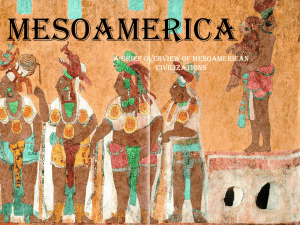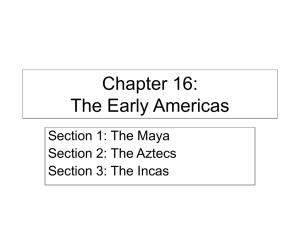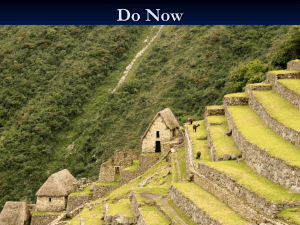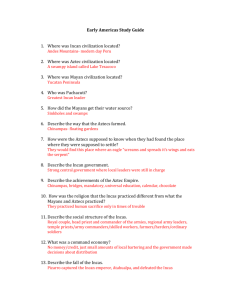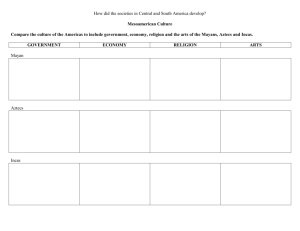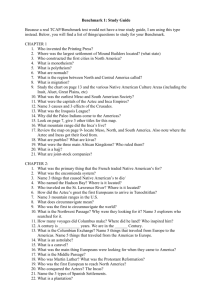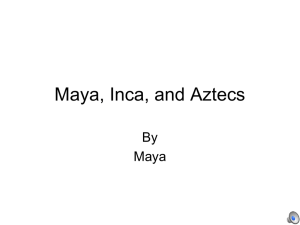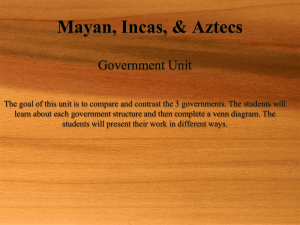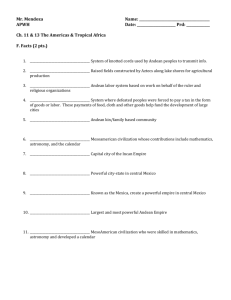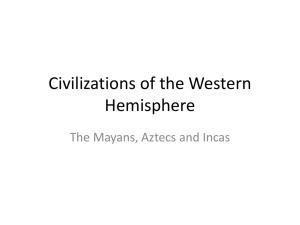The Mayan, Incan and Aztec Peoples – Student Notes
advertisement
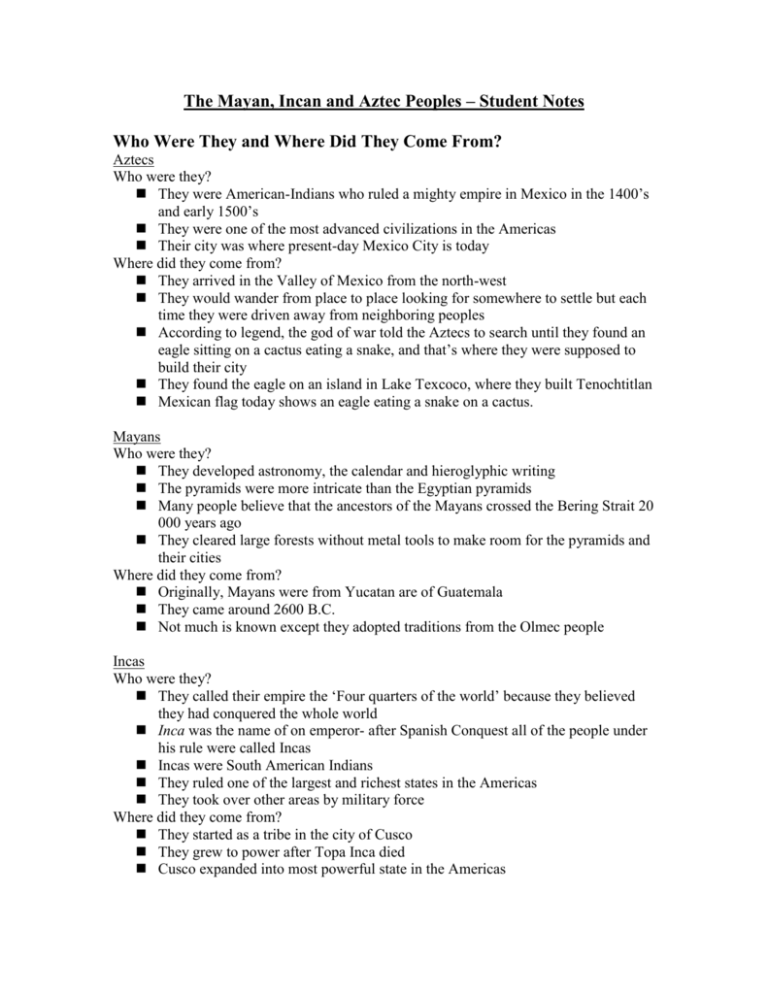
The Mayan, Incan and Aztec Peoples – Student Notes Who Were They and Where Did They Come From? Aztecs Who were they? They were American-Indians who ruled a mighty empire in Mexico in the 1400’s and early 1500’s They were one of the most advanced civilizations in the Americas Their city was where present-day Mexico City is today Where did they come from? They arrived in the Valley of Mexico from the north-west They would wander from place to place looking for somewhere to settle but each time they were driven away from neighboring peoples According to legend, the god of war told the Aztecs to search until they found an eagle sitting on a cactus eating a snake, and that’s where they were supposed to build their city They found the eagle on an island in Lake Texcoco, where they built Tenochtitlan Mexican flag today shows an eagle eating a snake on a cactus. Mayans Who were they? They developed astronomy, the calendar and hieroglyphic writing The pyramids were more intricate than the Egyptian pyramids Many people believe that the ancestors of the Mayans crossed the Bering Strait 20 000 years ago They cleared large forests without metal tools to make room for the pyramids and their cities Where did they come from? Originally, Mayans were from Yucatan are of Guatemala They came around 2600 B.C. Not much is known except they adopted traditions from the Olmec people Incas Who were they? They called their empire the ‘Four quarters of the world’ because they believed they had conquered the whole world Inca was the name of on emperor- after Spanish Conquest all of the people under his rule were called Incas Incas were South American Indians They ruled one of the largest and richest states in the Americas They took over other areas by military force Where did they come from? They started as a tribe in the city of Cusco They grew to power after Topa Inca died Cusco expanded into most powerful state in the Americas Social Organization and Society Maya Social Organization • Maya cities were not united to form an empire • ~ Each city was a separate state • ~ The city states had been united together through various traditional ceremonies, such as marriage, trade, art, common language, writing system, and religious aspects • ~ There were over 60 city states Mayan Social System • ~ The king had a right to collect taxes and had hereditary rule; top of social ranking • ~Nobles could be anyone; war captains, town councilors, prophets anyone below the king • ~ Priest means the highest one of the sun, they stand under the Nobles • ~ Peasants had few rights • ~ Slaves had little - no rights Aztec Social Organization Every person lived in a Calpulli it is a group of families that came from one common ancestor ~Each capulli chose a leader to represent their government ~ Gathered their own taxes and provided soldiers ~ Had its own temple and school only boys attend ~ 3 classes: nobles, common people and slaves ~ Nobles-priests, warriors, administrators ~ Commoners-merchants, farmers ~ Slaves-criminals, prisoners of war ~ Emperor above everyone, treated as deities ~ Emperor appointed judges, generals, governors and chiefs of people defeated by Aztecs ~ Death was a common penalty ~ Mutilation was common Inca Social Organization Expanded by conquering neighboring peoples ~ Was a highly regimented society ~ Emperor, believed by the Incas to be a descendant of the sun god ~ Each governor appointed officials to lead smaller groups of 1000 people ~ The leaders of conquered people became part of the Inca government The Incas made sure that an Inca princess married the chief of the conquered people ~ Commoners were not allowed to travel on the well developed roads ~ Wherever the Incas conquered they made people learn their language ~ Language was used to unite people Clothing Aztec Aztec warriors wore brightly colored clothing with headdresses made of feathers. The high-ranked people, mostly emperors, warriors and priests, wore cotton, while the commoners wore clothing made of coarser materials. The women wore long skirts with poncho-like tops, and the men wore loin cloths and occasionally a cape to cover their shoulders. Capes were very important to the Aztec people. Mayan Like the Aztecs, Mayan clothing was mostly made of cotton and woven with a loom. The poor dressed very simply, while the rich wore more elaborate clothing that was colored with dye made of ground up plants or insects. The women wore long, loose skirts or dresses, but would occasionally wear shawls as well. The poor men wore loin clothes, but the rich men wore skirts, sandals, and richly ornamented belts. They also wore jewelry made of jade, gold, silver, bone, wood and shells. Inca The Inca men wore a form of sleeveless, knee-length tunic that was made by folding a rectangular piece of cloth in half and sewing in arm holes. The women wore long dresses with a cape over their shoulders. Both women and men wore elaborately decorated belts and hats, the quality of which indicated their social rank. The fanciest, most brightly colored hats were worn by the best warriors only. Some Inca clothing has been preserved to this day by the cold, dry climate of the Andes Mountains. Housing Aztecs Most Aztecs lived in simple homes that consisted of one or two rooms and a place to cook. The walls were made of wattle (sticks interwoven with branches, twigs, or reeds) covered in mud. The roofs were made of thatched leaves from the agave plant. Most homes had very little furniture, low wooden benches, boxes and baskets for storing clothing and tools, and reed mats which were slept on. The homes of extended family shared a court yard and garden plot. They grew enough food in their garden to support their family. The higher class had two story houses with many rooms. They were built with rocks or mud bricks. Mayans Rulers and priests lived near central plaza in contained large apartments. Merchants, craftspeople, artists and government people lived in the towns. More modest than those of the rich. Homes were built on raised platforms to keep them cool and free of crawling insects. Walls were made of framework, poles plastered over with dry earth. The roofs were thatched, and steeply pitched to keep the hut cool. Peasants homes were one room homes, with a steeply thatched roof and were located in the farming areas Incas Most homes were simple and usually had one room. If they lived in the mountains they built their houses out of stone with thatched roofs. People who lived by the ocean made their houses out of adobe All doors and windows faced a courtyard. Food and Farming Mayans What They Ate • Corn was the main crop, usually made into soup or tortillas • Meat included deer, rabbits, turkeys and dried fish • Corns, pumpkins, avocados, chili peppers, sweet potatoes and cacao were made by the Mayans first • Farm provided most food for the Mayans grown by peasants Farming • They dug canals to drain the swampy grounds • On hilly slopes, they stored soil behind stone walls • Made piles of dirt to grow crops in on mountaintops, they looked like giant stairs • They dammed rivers for a steady supply of water • Built reservoirs for irrigation • They used sticks to make holes in the soil for seeds because they didn’t have ploughs, metal tools, horses, oxen or wheeled vehicles • Without special tools, they still got their work done and had enough food for everyone Incas Farming • Farmers sometimes kept llamas for food and wool and alpacas for wool • For planting they used a digging stick that was a shaped like a chisel they increased the amount they could grow in their mountain areas by terracing the sides of the mountains • Used stones to make a pathway for water to flow from its source • They collected lots of bird dropping to use as fertilizer and spread them on fields What they Ate • Corn, potatoes, and millet, cotton and beans Aztecs What They Ate • They both raised and ate turkeys and dogs, also they ate snakes and rats. • Trapped ducks and fish • Mostly ate corn, tortillas, beans, chili, peppers, and meat • They also ate blue/green algae Farming • Was the basis of economy and society • They used simple hoes and digging sticks to plant crops • The main crops were corn, peppers, tomatoes, beans, and squash • All available land was farmed • Drained swamps to make more farm land • Families tended their own gardens and grew fruits and vegetables Education Incas • • • • • • • • • • • • • Only children to learn where the sons of the Sapa Inca nobles Boys learned about law and geography Other gifted students were allowed schooling if they showed promise Writing was not taught because they had no written language School was run by priests and they beat the children if they misbehaved Arithmetic education was very important Children that stayed home were expected to learn from parents Boys learned hunting and preparing the ground for crops They learnt furnishing for their homes Boys were also trained soldiers Manhood was considered to be at age 14 Women learned how to cook, weave cloth, and sew clothing Sapa Inca ( Highest priest) received education in domestic arts Mayans • Writing was a sacred gift from the gods • Only a small group of people learned to read and write • Maya writing was in the form of hieroglyphs • The glyphs represented words or syllables and where combined to form words and concepts • Used writing as propaganda tool rather than as a way of recording their history • Scribes carved glyphs into stone and wood on monuments and architecture or paint them on walls Aztecs • Girls were trained in their homes from an early age for their role after marriage • Male children attended school between the ages of 12 and 15 • They learned religious songs and public speaking • Studied history and religion • Young nobles attended temple schools • Trained to be soldiers, priests, lawyers, and engineers • Women could participate in business, own property and take legal action • Wife in the Aztec language means “one who is the owner of man” • If a women is mistreated by her husband she could divorce him Spirituality Inca • • • • Worship many deities Most Important gods and goddesses of all the deities were sun, moon, corn, lightning and rainbows. Sang hymns to their deities while they worked The Incas believed to give the first share of the crop to their deities Aztec • The Aztecs strongly believed human sacrifices. • Men and women were both sacrificed. • Without these sacrifices the Aztecs believed that Deities would not let the sun rise. Mayan • Believed in Spirits • Caves were believed to be a place where the real world and spiritual world met • Believed every creation had an unseen power The Arts Mayan The Maya created astonishing sculptures, statues, jewelry and carvings, as well as books with drawings and illustrations that show what life was like back in Mayan times Most Mayan art was a reflection of lifestyle, culture or had religious meaning The Maya had about 800 glyphs Art was made upon paper and plaster, carvings in wood, Obsidian, bone, shells, jade and stone, clay and stucco models, and terracotta figurines from molds Stelae were carved to show a Mayan god or ruler. There were glyphs on the stelea to tell information about the rule, family and date the stelea was made Aztec Aztec art was mostly used for religious ceremonies and expressions Art was usually paying tribute to a god or goddess so the art was used for communication Inca The Inca believed that the sun god had ownership of all the gold. As a result, they made most of their art work and buildings out of gold. The Incas used ceramics, precious metals, and textiles for their art Ceramics were painted with numerous designs like animals, birds, waves, domestic animals and geometric patterns Shaping items from a variety of metals was another form of Incan art The Inca attire was also very interesting art On tapestry and textiles the Incas used energetic colours and geometric patterns Most of the Incan art was melted down by the Spanish to please their want for gold and silver Chichen Itza Where is it? Located in the center of Yucatan Peninsula (present day Mexico) What is it? Main city of the Maya lowlands. Some of the Mexican culture came from this city. Name means “at the mouth of the well of Itza” History All rivers run underground There are two huge sink holes or cenotes used for human sacrifice Also where they get water Jade and other stone and human remains are found in the ground because of their beliefs Political Organization Chichen Itza was thought to be ruled by a council of Elite people Decline of Chichen Itza It fell around 1000 A.D. Believed to be conquered by Mayapans in the 13th century As it fell, population decreased Arrival of Spaniards 1526- Spanish conquistador Francisco De Montejo started the invasion 1527- invaded almost all of Yucatan Peninsula Machu Picchu • • • • Was built during the height Incan empire Situated in the Andes Mountains in Peru Was never found by the Spaniards Abandoned in 1527 during a civil war due to the outrageous costs the city needed Life in Machu Picchu • Around 1200 residents • Majority of the population was either construction workers or gardeners who took care of the city • City included many houses and apartments, temples and storage facilities • Potatoes and corn were grown and water was accessed from an underground stream
